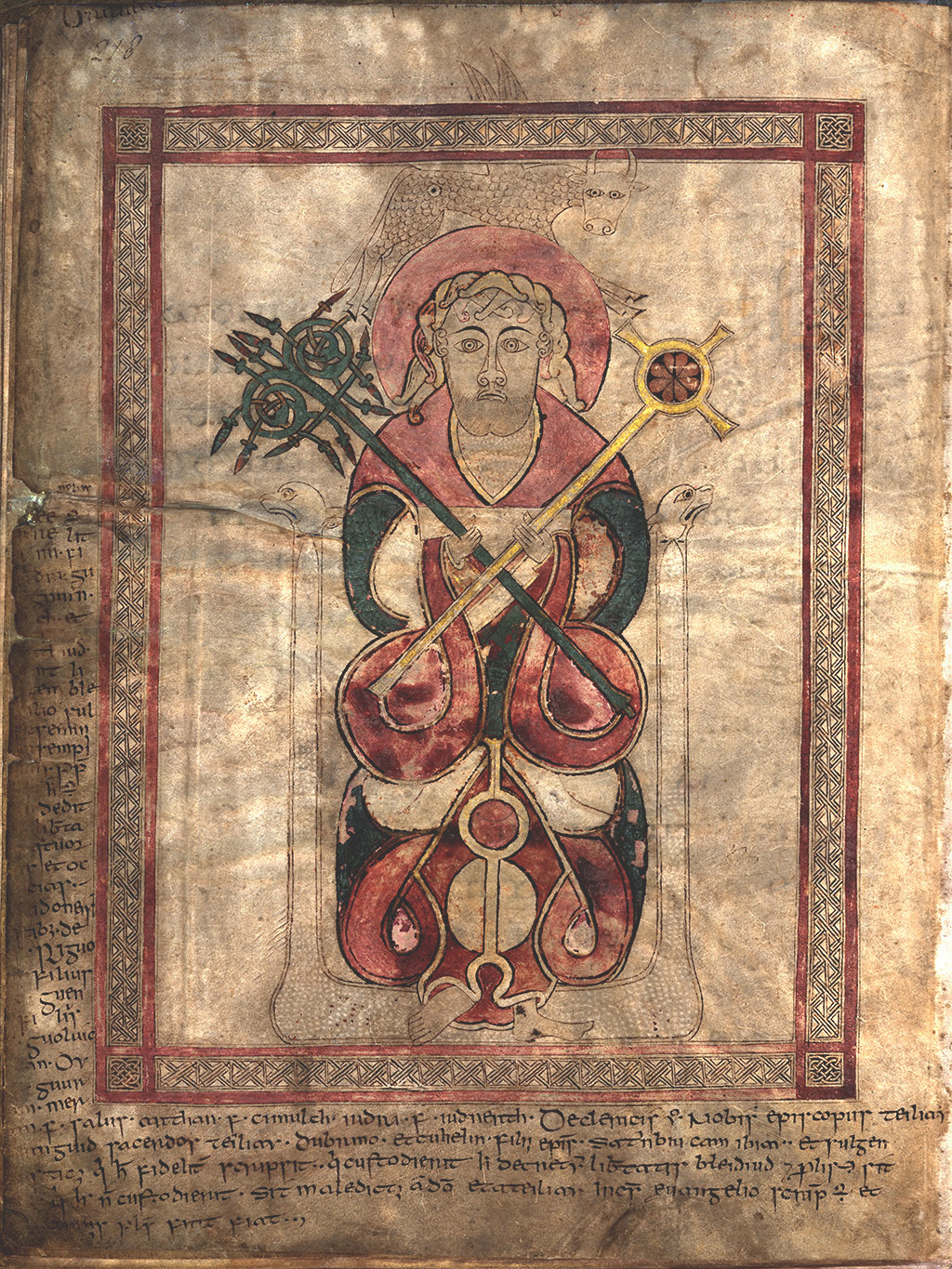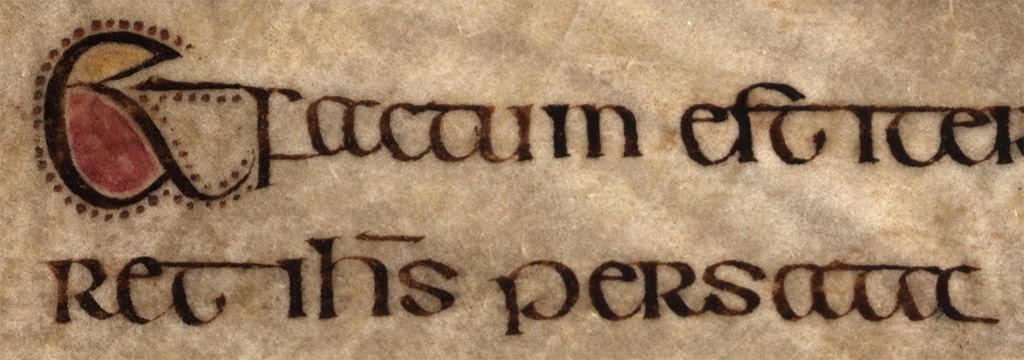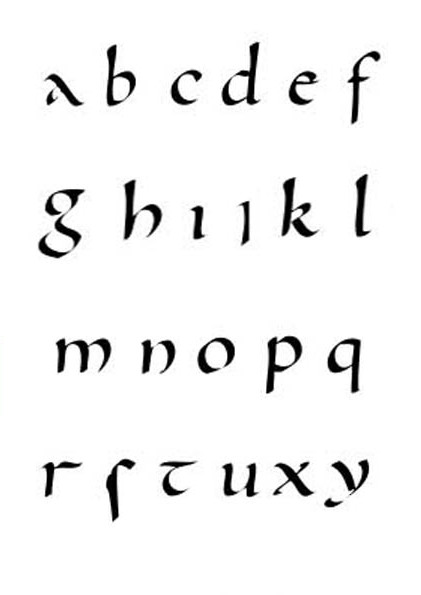|
Breton Gospel Book (British Library, MS Egerton 609)
British Library, Egerton MS 609 is a Breton Gospel Book from the late or third quarter of the ninth century. It was created in France, though the exact location is unknown. The large decorative letters which form the beginning of each Gospel are similar to the letters found in Carolingian manuscripts, but the decoration of these letters is closer to that found in insular manuscripts, such as the Book of Kells and the Lindisfarne Gospels. However, the decoration in the Breton Gospel Book is simpler and more geometric in form than that found in the Insular manuscripts. The manuscript contains the Latin text of St Jerome's letter to Pope Damasus, St. Jerome's commentary on Matthew, and the four Gospels, along with prefatory material (an introduction) and canon tables (an index for a medieval manuscript). This manuscript is part of the Egerton Collection in the British Library. Provenance The Breton Gospel Book was produced in France, most likely in Brittany or Tours. In the fifte ... [...More Info...] [...Related Items...] OR: [Wikipedia] [Google] [Baidu] |
Brittany
Brittany (; french: link=no, Bretagne ; br, Breizh, or ; Gallo language, Gallo: ''Bertaèyn'' ) is a peninsula, Historical region, historical country and cultural area in the west of modern France, covering the western part of what was known as Armorica during the period of Roman occupation. It became an Kingdom of Brittany, independent kingdom and then a Duchy of Brittany, duchy before being Union of Brittany and France, united with the Kingdom of France in 1532 as a provinces of France, province governed as a separate nation under the crown. Brittany has also been referred to as Little Britain (as opposed to Great Britain, with which it shares an etymology). It is bordered by the English Channel to the north, Normandy to the northeast, eastern Pays de la Loire to the southeast, the Bay of Biscay to the south, and the Celtic Sea and the Atlantic Ocean to the west. Its land area is 34,023 km2 . Brittany is the site of some of the world's oldest standing architecture, ho ... [...More Info...] [...Related Items...] OR: [Wikipedia] [Google] [Baidu] |
Lichfield Gospels
The Lichfield Gospels (recently more often referred to as the St Chad Gospels, but also known as the Book of Chad, the Gospels of St Chad, the St Teilo Gospels, the Llandeilo Gospels, and variations on these) is an 8th-century Insular Gospel Book housed in Lichfield Cathedral. There are 236 surviving pages, eight of which are illuminated. Another four contain framed text. The pages measure 30.8 cm by 23.5 cm. The manuscript is also important because it includes, as marginalia, some of the earliest known examples of written Old Welsh, dating to the early part of the 8th century.Encyclopaedia Wales; University of Wales Press; main editor: John Davies; page 577 Peter Lord dates the book at 730, placing it chronologically before the Book of Kells but after the Lindisfarne Gospels. Marginal entries indicate that the manuscript was in the possession of the church of St Teilo in Wales at some point in the 9th century and eventually came into the possession of Lichfield Cath ... [...More Info...] [...Related Items...] OR: [Wikipedia] [Google] [Baidu] |
Book Of Revelation
The Book of Revelation is the final book of the New Testament (and consequently the final book of the Christian Bible). Its title is derived from the first word of the Koine Greek text: , meaning "unveiling" or "revelation". The Book of Revelation is the only apocalyptic book in the New Testament canon. It occupies a central place in Christian eschatology. The author names himself as simply "John" in the text, but his precise identity remains a point of academic debate. Second-century Christian writers such as Papias of Hierapolis, Justin Martyr, Irenaeus, Melito of Sardis, Clement of Alexandria, and the author of the Muratorian fragment identify John the Apostle as the "John" of Revelation. Modern scholarship generally takes a different view, with many considering that nothing can be known about the author except that he was a Christian prophet. Modern theological scholars characterize the Book of Revelation's author as "John of Patmos". The bulk of traditional sources ... [...More Info...] [...Related Items...] OR: [Wikipedia] [Google] [Baidu] |
Ezekiel
Ezekiel (; he, יְחֶזְקֵאל ''Yəḥezqēʾl'' ; in the Septuagint written in grc-koi, Ἰεζεκιήλ ) is the central protagonist of the Book of Ezekiel in the Hebrew Bible. In Judaism, Christianity, and Islam, Ezekiel is acknowledged as a Hebrew prophet. In Judaism and Christianity, he is also viewed as the 6th-century BCE author of the Book of Ezekiel, which reveals prophecies regarding the destruction of Jerusalem, and the restoration to the land of Israel. The name Ezekiel means "God is strong" or "God strengthens". In the Bible The author of the Book of Ezekiel presents himself as Ezekiel, the son of Buzi, born into a priestly (kohen) lineage. Apart from identifying himself, the author gives a date for the first divine encounter which he presents: "in the thirtieth year". Ezekiel describes his calling to be a prophet by going into great detail about his encounter with God and four "living creatures" with four wheels that stayed beside the creatures. Liv ... [...More Info...] [...Related Items...] OR: [Wikipedia] [Google] [Baidu] |
Zoomorphism
The word ''zoomorphism'' derives from the Greek ζωον (''zōon''), meaning "animal", and μορφη (''morphē''), meaning "shape" or "form". In the context of art, zoomorphism could describe art that imagines humans as non-human animals. It can also be defined as art that portrays one species of animal like another species of animal or art that uses animals as a visual motif, sometimes referred to as "animal style." In ancient Egyptian religion, deities were depicted in animal form which is an example of zoomorphism in not only art but in a religious context. It is also similar to the term therianthropy; which is the ability to shape shift into animal form, except that with zoomorphism the animal form is applied to a physical object. It means to attribute animal forms or animal characteristics to other animals, or things other than an animal; similar to but broader than anthropomorphism. Contrary to anthropomorphism, which views animal or non-animal behavior in human terms, zoo ... [...More Info...] [...Related Items...] OR: [Wikipedia] [Google] [Baidu] |
Eusebian Canons
Eusebian canons, Eusebian sections or Eusebian apparatus, also known as Ammonian sections, are the system of dividing the four Gospels used between late Antiquity and the Middle Ages. The divisions into chapters and verses used in modern texts date only from the 13th and 16th centuries, respectively. The sections are indicated in the margin of nearly all Greek and Latin manuscripts of the Bible, and usually summarized in canon tables at the start of the Gospels. There are about 1165 sections: 355 for Matthew, 235 for Mark, 343 for Luke, and 232 for John; the numbers, however, vary slightly in different manuscripts. The canon tables were made to create a sense of divinity within the reader’s soul, to understand and reflect upon the various colors and patterns to achieve a higher connection with God. Authorship Until the 19th century it was mostly believed that these divisions were devised by Ammonius of Alexandria, at the beginning of the 3rd century ( 220), in connection w ... [...More Info...] [...Related Items...] OR: [Wikipedia] [Google] [Baidu] |
MS Egerton 609 F
MS, ms, Ms, M.S., etc. may refer to: Arts and entertainment * ''Ms.'' (magazine), an American feminist magazine * Metal Storm (webzine), a heavy metal website based in Estonia Businesses and organizations * MS-13, criminal gang * Missionaries of La Salette, a Catholic male religious order * Młodzi Socjaliści (Young Socialists), a former Polish socialist youth organization * Morgan Stanley, a US investment bank (NYSE stock symbol: MS) * Mjólkursamsalan, an Icelandic dairy company Educational qualifications * Master of Science, a master's degree in the field of science * Master of Surgery, an advanced medical degree * Master Sommelier, a terminal degree in the field of wine * '' Mastère spécialisé'', a French postgraduate ''grande école'' master's degree Medicine * Mitral stenosis, narrowing of the mitral valve of the heart * Morphine sulfate, an opiate pain-relieving drug * Multiple sclerosis, a disease of the nervous system Military * Master seaman, a non-commissio ... [...More Info...] [...Related Items...] OR: [Wikipedia] [Google] [Baidu] |
Insular Script
Insular script was a medieval script system originating from Ireland that spread to Anglo-Saxon England and continental Europe under the influence of Irish Christianity. Irish missionaries took the script to continental Europe, where they founded monasteries such as Bobbio. The scripts were also used in monasteries like Fulda, which were influenced by English missionaries. They are associated with Insular art, of which most surviving examples are illuminated manuscripts. It greatly influenced Irish orthography and modern Gaelic scripts in handwriting and typefaces. Insular script comprised a diverse family of scripts used for different functions. At the top of the hierarchy was the Insular half-uncial (or "Insular majuscule"), used for important documents and sacred text. The full uncial, in a version called "English uncial", was used in some English centres. Then "in descending order of formality and increased speed of writing" came "set minuscule", "cursive minuscule" and ... [...More Info...] [...Related Items...] OR: [Wikipedia] [Google] [Baidu] |
Half Uncial
Uncial is a majuscule Glaister, Geoffrey Ashall. (1996) ''Encyclopedia of the Book''. 2nd edn. New Castle, DE, and London: Oak Knoll Press & The British Library, p. 494. script (written entirely in capital letters) commonly used from the 4th to 8th centuries AD by Latin and Greek scribes. Uncial letters were used to write Greek and Latin, as well as Gothic and Coptic. Development Early uncial script most likely developed from late rustic capitals. Early forms are characterized by broad single-stroke letters using simple round forms taking advantage of the new parchment and vellum surfaces, as opposed to the angular, multiple-stroke letters, which are more suited for rougher surfaces, such as papyrus. In the oldest examples of uncial, such as the fragment of '' De bellis macedonicis'' in the British Library, of the late 1st-early 2nd century, all of the letters are disconnected from one another, and word separation is typically not used. Word separation, however, is characteris ... [...More Info...] [...Related Items...] OR: [Wikipedia] [Google] [Baidu] |
Paper Marbling
Paper marbling is a method of aqueous surface design, which can produce patterns similar to smooth marble or other kinds of stone. The patterns are the result of color floated on either plain water or a viscous solution known as size, and then carefully transferred to an absorbent surface, such as paper or fabric. Through several centuries, people have applied marbled materials to a variety of surfaces. It is often employed as a writing surface for calligraphy, and especially book covers and endpapers in bookbinding and stationery. Part of its appeal is that each print is a unique monotype. Procedure There are several methods for making marbled papers. A shallow tray is filled with water, and various kinds of ink or paint colors are carefully applied to the surface with an ink brush. Various additives or surfactant chemicals are used to help float the colors. A drop of "negative" color made of plain water with the addition of surfactant is used to drive the drop of color into a ... [...More Info...] [...Related Items...] OR: [Wikipedia] [Google] [Baidu] |
Codex
The codex (plural codices ) was the historical ancestor of the modern book. Instead of being composed of sheets of paper, it used sheets of vellum, papyrus, or other materials. The term ''codex'' is often used for ancient manuscript books, with handwritten contents. A codex, much like the modern book, is bound by stacking the pages and securing one set of edges by a variety of methods over the centuries, yet in a form analogous to modern bookbinding. Modern books are divided into paperback or softback and those bound with stiff boards, called hardbacks. Elaborate historical bindings are called treasure bindings. At least in the Western world, the main alternative to the paged codex format for a long document was the continuous scroll, which was the dominant form of document in the Ancient history, ancient world. Some codices are continuously folded like a concertina, in particular the Maya codices and Aztec codices, which are actually long sheets of paper or animal skin folded ... [...More Info...] [...Related Items...] OR: [Wikipedia] [Google] [Baidu] |
Carolingian Minuscule
Carolingian minuscule or Caroline minuscule is a script which developed as a calligraphic standard in the medieval European period so that the Latin alphabet of Jerome's Vulgate Bible could be easily recognized by the literate class from one region to another. It is thought to have originated before AD 778 at the scriptorium of the Benedictine monks of Corbie Abbey, about north of Paris, and then developed by Alcuin of York for wide use in the Carolingian Renaissance. Alcuin himself still wrote in a script which was a precursor the Carolingian minuscule, which slowly developed over three centuries. He was most likely responsible for copying and preserving the manuscripts and upkeep of the script. It was used in the Holy Roman Empire between approximately 800 and 1200. Codices, pagan and Christian texts, and educational material were written in Carolingian minuscule. After blackletter developed out of it, the Carolingian minuscule became obsolete, until the 14th century Ital ... [...More Info...] [...Related Items...] OR: [Wikipedia] [Google] [Baidu] |








